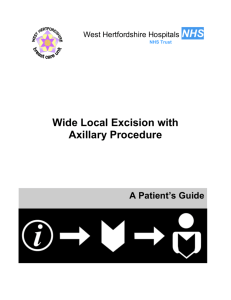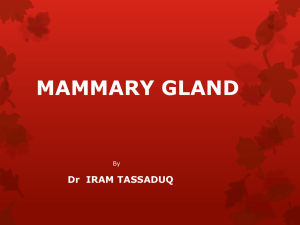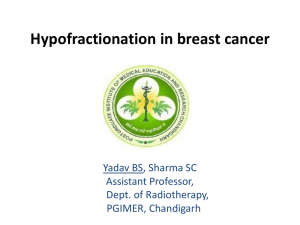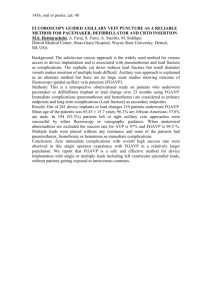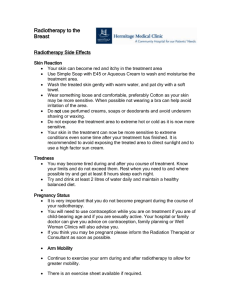Consensus For Condition Management | File Size: 57 KB
advertisement
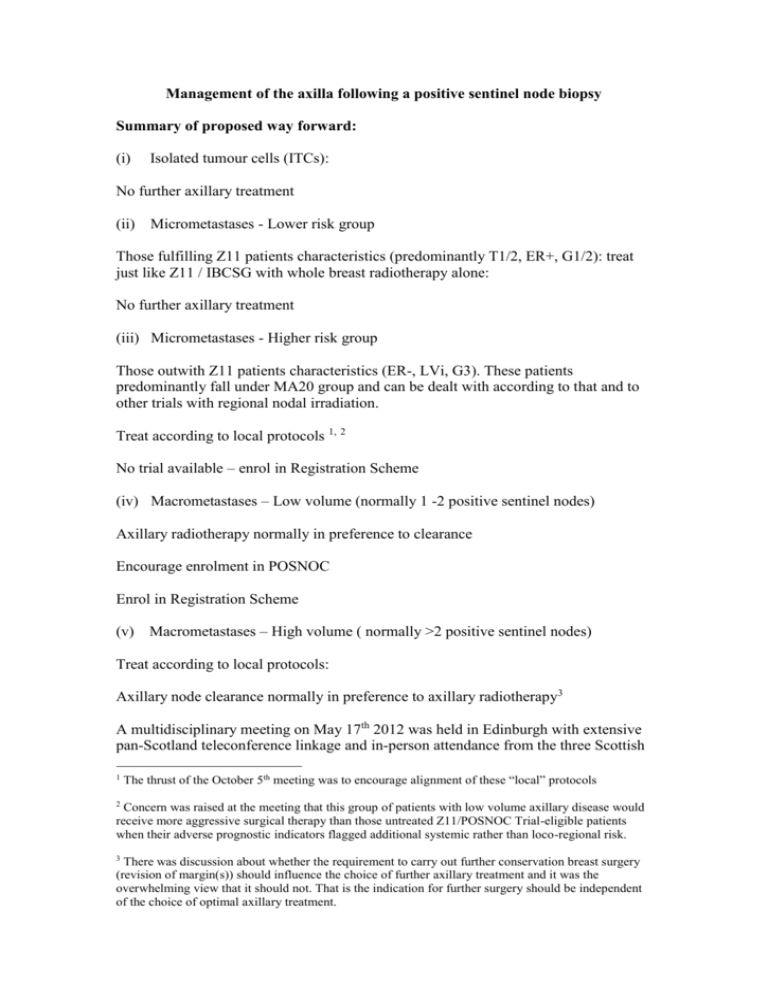
Management of the axilla following a positive sentinel node biopsy Summary of proposed way forward: (i) Isolated tumour cells (ITCs): No further axillary treatment (ii) Micrometastases - Lower risk group Those fulfilling Z11 patients characteristics (predominantly T1/2, ER+, G1/2): treat just like Z11 / IBCSG with whole breast radiotherapy alone: No further axillary treatment (iii) Micrometastases - Higher risk group Those outwith Z11 patients characteristics (ER-, LVi, G3). These patients predominantly fall under MA20 group and can be dealt with according to that and to other trials with regional nodal irradiation. Treat according to local protocols 1, 2 No trial available – enrol in Registration Scheme (iv) Macrometastases – Low volume (normally 1 -2 positive sentinel nodes) Axillary radiotherapy normally in preference to clearance Encourage enrolment in POSNOC Enrol in Registration Scheme (v) Macrometastases – High volume ( normally >2 positive sentinel nodes) Treat according to local protocols: Axillary node clearance normally in preference to axillary radiotherapy3 A multidisciplinary meeting on May 17th 2012 was held in Edinburgh with extensive pan-Scotland teleconference linkage and in-person attendance from the three Scottish 1 The thrust of the October 5th meeting was to encourage alignment of these “local” protocols 2 Concern was raised at the meeting that this group of patients with low volume axillary disease would receive more aggressive surgical therapy than those untreated Z11/POSNOC Trial-eligible patients when their adverse prognostic indicators flagged additional systemic rather than loco-regional risk. 3 There was discussion about whether the requirement to carry out further conservation breast surgery (revision of margin(s)) should influence the choice of further axillary treatment and it was the overwhelming view that it should not. That is the indication for further surgery should be independent of the choice of optimal axillary treatment. Breast Cancer Networks. A further meeting was held on October 5th 2012 again with excellent in-person and tele-presence attendance and this document summarises the position following that meeting. There was broad agreement that the ground was shifting in relation to the management of the axilla in patients with sentinel node-positive breast cancer and that there was merit in pursuing a consensus for future practice across Scotland. This short paper summarises the evidence relating to the four main clinical scenarios for node-positive breast disease and based on that evidence proposes an optimum management approach for each scenario in the future. The five scenarios are: - ITCs Micromets – lower risk Micromets – higher risk Macromets – low volume Macromets – higher volume4 Working down this list there is increasing uncertainty and debate about the appropriate further management of patients in each group. Case load: It is estimated that of the 3000 cases of invasive breast cancer seen annually in Scotland with a 24% node-positive rate and a proportion proceeding directly to clearance the positive sentinel node rate will be about 7% of all cases (<300 pa). Taking the first two groups there are two points that need to be kept in mind: 1. Do micrometastases and isolated tumour cells predict for the involvement of nonsentinel axillary lymph nodes? 2. What is the prognostic significance of micrometastases and isolated tumour cells? Isolated Tumour Cells (ITCs) These are defined as small clusters of nodal metastatic tumour cells ≤ 0.2 mm in greatest dimension. There are inconsistencies in the reporting of isolated tumour cells by pathologists and these need to be minimised by clear guidelines. There is a broad consensus however that patients with ITCs only do not require further axillary treatment. Micrometastases 4 It is appreciated that in centres where standard sentinel node biopsy applies and additional sample nodes are not taken the two macromets groups may not be separable. These are defined as small nodal tumour deposits >0.2mm - 2.0 mm in greatest dimension. The definition allows for multiple deposits and this needs to be kept in mind when interpreting the literature on this subject. Also pathological guidelines recommend cutting extra levels on a case with suspected micromets to see if they get any bigger in subsequent sections. Upstaging is reported in the literature between 5% & 30% of cases. Involvement of non-sentinel axillary nodes: Viale et al1 found differences in frequency of non-sentinel node metastases in relation to the size of the micrometastasis, being less if < 1mm. Other factors that have been found to relate to non-sentinel node metastases in the presence of sentinel node micrometastasis include tumour size1, 2, 3, grade 2 and vascular invasion 4. These additional qualifiers would support a stratification of cases with micrometastases into lower and higher risk groups if the difference proved to be clinically significant. Evidence from the Z011 trial also support stratification with ER negative, Grade 3, LVi +ve, being allocated to the poorer prognostic group. 5 Prognosis: Weaver and colleagues in a large recent review of 602 patients from the NSABP B32 Trial with ITCs or micromets who had received no further axillary treatment found hazard ratios of 1.27 and 1.60 when compared with patients with node negative disease and 5 year survivals of 98.4% and 97.8% respectively (96% for macromets). 6 Similar conclusions were reached by de Boer and colleagues in a large recent Danish study. 7 Future management of patients with micrometastases: The study by Weaver et al 6 showed no significant disadvantage for women who underwent sentinel-lymph-node biopsy alone as compared with women who underwent sentinel-lymph-node biopsy plus axillary dissection and if it is accepted that axillary radiotherapy and axillary node dissection are “equivalents” in management terms then the risk to the patient with micrometastases of offering no further axillary treatment is low and may outweigh the risks of further axillary treatment. It is proposed therefore that patients with micrometastases should be stratified as follows: 1. Micromets: Those fulfilling Z11 patients characteristics (predominantly T1/2, ER+, G1/2): treat just like Z11 / IBCSG with "High/standard" tangent. NB: on the basis that this was the likely technique used but to be reviewed once more informations are available. This represents the major change in practice. 2. Micromets: those outwith Z11 patients characteristics (ER-, LVI, G3). These patients predominantly fall under MA20 group and can be dealt with according to that and to other trials with axillary radiotherapy. It was noted with some concern at the October 5th meeting that this group of patients were remaining in a group where further locoregional treatment was being given when their adverse prognostic indicators flagged increased systemic risk. This was in contrast to the low volume macromets group who might be placed in a “no treatment” arm of a randomised trial. Low volume macromets and high volume macromets Currently there is very active debate about the optimum management of a patient with a positive SNB. Data from the American College of Surgeons Oncology Group trial Z0011 have shown equivalent survival in patients with one or two positive lymph nodes in those patients offered further ANC and those who received no further surgery. Also local axillary recurrence was less than 1% in the untreated (no further surgery) group. Omission of axillary radiotherapy in the absence of ANC does result in a higher axillary recurrence rate. 8 A more recent study showed equivalence between ANC and axillary radiotherapy in a selected group of patients. 9 This was also shown by the AMAROS study. 10 There is difficulty in interpreting the trials data on macromets because of either failure to standardise radiotherapy and/or to a lesser extent, surgery, in the various trials that have been reported. The general consensus at the May 17th meeting was that there is uncertainty surrounding the management of patients with low volume macromets (1 or 2 positive nodes) but very little uncertainty about those patients that have higher volume disease where there is strong support for further axillary treatment but some debate as to whether this should be radiotherapy or surgery. Given the evidence that surgery and radiotherapy may be of equal efficacy 9 10 it was emphasised at the October 5th meeting that a requirement for further local surgery (e.g. revision of a margin) should not normally dictate the choice of further axillary treatment. Radiotherapy considerations These are taken from a recent e mail kindly sent by Dr Alhasso: It is important to explain again that with standard 2 fields breast radiotherapy we will unavoidably have to irradiate a significant part of the axilla whether we like / want it or not and that the terminology of "high tangent" or "standard tangent" is in reality very flexible and not very specific just like the variation in technical aspect of the surgical clearance of the axilla. I do not expect Z11 or IBCSG to come up with any detailed description of their XRT technique. We also have to keep in mind that in supine position (for XRT), the upper extent of the breast will be higher than normal and for standard tangent it may end up including level 3 unintentionally. However, when we describe High Tangents it usually reflect intentional irradiation of the Axilla which is probably what happened in Z11 and most patient in IBCSG 23-10. As shown on my slides previously, the difference in terms of volume of irradiation is relatively small and that toxicity is not expected to be different (although this has never been compared). Advantages for regional nodal irradiation (RNI) over node clearance (ANC) in the high risk (macro mets) patient are: •At least equal efficacy and early survival advantages with RNI (for the high risk / Macromets) •Patients are attending for radiotherapy to Breast / Chest wall (majority) anyway. So minor extra for patients. •No need for 2nd surgery and GA. •Patients are more likely to start systemic therapy (chemo in particular) earlier than if cALND is carried out. •Sparing acute surgical complications. On October 5th Dr Al-hasso described current terminology for the various radiotherapy treatment options for breast cancer including the difference between whole breast radiotherapy and whole breast radiotherapy with high tangents. The former is designed to avoid giving radiotherapy to the axilla while the latter gives some radiotherapy to the lower axilla. Following further discussion there were clearly practice preferences on this point but it was also agreed that in reality the differences between the two treatments were quite small and it was accepted that patient-topatient variation was also inevitable due to differences in individual habitus etc. There followed some discussion about axillary radiotherapy following a mastectomy that was accompanied by a positive sentinel node biopsy and whether the same axillary treatment guidelines could be applied to these patients as agreed for breast conservation patients. There was a difference in view amongst practitioners on this point also which would be revisited when further evidence became available. Other Considerations 1. On October 5th Dr Gagliardi presented data concerning the risks of overtreating patients, particularly screening patients, with positive axillary staging and confirmed that this was the case although numbers were small. It was agreed that the concept of overtreatment was inevitably influenced by the treatment dynamics as the evidence base drove change in practice. Nevertheless colleagues agreed that it was essential to review critically axillary staging information at a multidisciplinary meeting before deciding on how to treat the axilla – sentinel node biopsy, radiotherapy or clearance. 2. Setting aside the non-availability of SNB in some places there are minor differences in surgical practice around the country. In Edinburgh we frequently receive a combination of sentinel nodes with an accompanying node sample. 1 Viale G, Maiorano E, Mazzarol G et al. Histologic detection and clinical implications of micrometastases in axillary sentinel lymph nodes for patients with breast carcinoma. Cancer 2001; 92: 1378-1384. 2 den Bakker MA, van Weeszenberg A, de Kanter AY et al. Non-sentinel lymph node involvement in patients with breast cancer and sentinel node micrometastasis; too early to abandon axillary clearance. J Clin Pathol 2002; 55: 932-935. 3 Dabbs DJ, Fung D, Landsittel D, McManus K, Johnson R. Sentinel lymph node micrometastasis as a predictor of axillary tumor burden. The Breast J 2004; 10: 101-105. 4 Carcoforo P, Bergossi L, Basaglia E et al. Prognostic and therapeutic impact of sentinel node micrometastasis in patients with invasive breast cancer. Tumori 2002; 88: 54-55. 5 Giuliano AE, McCall L, Beitsch P, et al. Locoregional recurrence after sentinel lymph node dissection with or without axillary dissection in patients with sentinel lymph node metastases: The American College of Surgeons Oncology Group Z0011 randomized trial. Ann Surg 2010; 252: 426-432. 6 Weaver DJ, Ashikarga T, Krag DN et al. Effect of Occult Metastases on Survival in Node-Negative Breast Cancer. N Engl J Med 2011, 364: 412-21 7 de Boer, M., van Deurzen, CHM,van Dijck JAAM. Micrometastases or Isolated Tumor Cells and the Outcome of Breast Cancer. N Engl J Med 2009; 361:653-663 8 Tjan-Heijnen VC, Pepels MJ, de Boer M et al. Impact of omission of completion axillary lymph node dissection (cALND) or axillary radiotherapy (ax RT) in breast cancer patients with micrometastases (pN1mi) or isolated tumor cells (pN0[i+]) in the sentinel lymph node (SN): Results from the MIRROR study. J Clin Oncol 2009; 27:18s, (suppl; abstr CRA506) 9 Barkley C, Burstein H, Smith B et al. Can Axillary Node Dissection Be Omitted in a Subset of Patients with Low Local and Regional Failure Rates? The Breast Journal, 2012;18: 23–27. DOI: 10.1111/j.1524-4741.2011.01178.x 10 Straver ME, Meijnen P, van Tienhoven G et al. Role of axillary clearance after a tumourpositive sentinel node in the administration of adjuvant therapy in early breast cancer. J Clin Oncol 2010: 28; 731-7.
